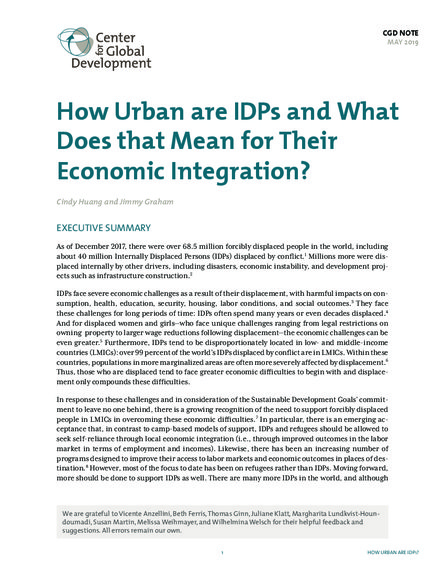
As of December 2017, there were over 68.5 million forcibly displaced people in the world, including about 40 million Internally Displaced Persons (IDPs) displaced by conflict. Millions more were displaced internally by other drivers, including disasters, economic instability, and development projects such as infrastructure construction.
IDPs face severe economic challenges as a result of their displacement, with harmful impacts on consumption, health, education, security, housing, labor conditions, and social outcomes. They face these challenges for long periods of time: IDPs often spend many years or even decades displaced. And for displaced women and girls—who face unique challenges ranging from legal restrictions on owning property to larger wage reductions following displacement—the economic challenges can be even greater. Furthermore, IDPs tend to be disproportionately located in low- and middle-income countries (LMICs): over 99 percent of the world’s IDPs displaced by conflict are in LMICs. Within these countries, populations in more marginalised areas are often more severely affected by displacement. Thus, those who are displaced tend to face greater economic difficulties to begin with and displacement only compounds these difficulties.
In response to these challenges and in consideration of the Sustainable Development Goals’ commitment to leave no one behind, there is a growing recognition of the need to support forcibly displaced people in LMICs in overcoming these economic difficulties. In particular, there is an emerging acceptance that, in contrast to camp-based models of support, IDPs and refugees should be allowed to seek self-reliance through local economic integration (i.e., through improved outcomes in the labor market in terms of employment and incomes). Likewise, there has been an increasing number of programs designed to improve their access to labor markets and economic outcomes in places of destination. However, most of the focus to date has been on refugees rather than IDPs. Moving forward, more should be done to support IDPs as well. There are many more IDPs in the world, and although as citizens they face fewer legal barriers to work, they nevertheless face serious economic challenges. Furthermore, with sound policies and support systems in place, greater economic integration can bring benefits not only to IDPs, but also to host communities, which can benefit from IDPs’ economic contributions.
Understanding the extent to which IDPs are currently concentrated in urban areas is an important step towards determining how best to implement programs and policies that enable IDPs to achieve self-reliance. To this end, we analyse data on the existing known locations of conflict-displaced IDPs in all LMICs and visualise their locations in an interactive map. The data, which can be accessed online, cover 17 countries and over 9 million conflict-displaced IDPs. The sample is not representative, so it does not allow us to estimate the total number of urban IDPs in the world, but it does allow us to create a lower bound for the number of urban IDPs and highlight the extent to which IDPs live in urban areas. To our knowledge, this is the most comprehensive attempt to date to determine urban rates among IDPs. This work builds on our previous paper, Are Refugees Located Near Urban Job Opportunities?, where we analysed and mapped the locations of refugees in 31 LMICs.
We find that millions of IDPs are located in urban areas and hundreds of thousands are located in major urban areas.[ii] Specifically, as table 1 shows, we find that about 4.4 million conflict-displaced IDPs are in urban areas, and nearly 1.5 million of them are in major urban areas with populations over 300,000. We also find that these urban populations are dispersed across various countries. Ten countries have at least 50,000 IDPs in urban areas and 10 countries have at least 10,000 in major cities. The data also suggest that about half of IDPs are female and nearly half are of working age.
Furthermore, some countries have very large urban populations: three—Afghanistan, Nigeria, and Iraq—each have over 500,000 IDPs in urban areas and at least 100,000 in major urban areas. It is also common for at least half of the IDP population in a given country to be urban. On the other hand, the vast majority of IDP populations for some countries, such as Niger and Chad, are in rural areas. Thus, there is a great deal of variation in urban-rural composition across countries that may in part reflect a country’s overall rate of urbanisation. In some cases, however, IDP populations are disproportionately rural compared to national populations, suggesting a potential opportunity to incentivise urbanisation in these contexts.
The analysis also highlights the paucity of data on the locations of IDPs within countries. As table 1 shows, there are only about 9.3 million IDPs with location data that allow for urban analysis (i.e., that allow us to determine whether they are in urban or rural locations)—and there were roughly 40 million conflict-displaced IDPs in the world as of December 2017. Furthermore, these 9.3 million IDPs are from only 17 countries, out of a total of 50 with at least 1,000 IDPs.
Links
Resource collections
- Innovation
- UN Habitat - Urban Response Collection
- Urban Response - Urban Crisis Preparedness and Risk Reduction
- Urban Response Collection - Community Engagement and Social Cohesion
- Urban Response Collection - Economic Recovery
- Urban Response Collection - Environment and Climate Change
- Urban Response Collection - Housing, Land and Property
- Urban Response Collection - Urban Crisis Response, Recovery and Reconstruction
- Urban Response Collection - Urban Resilience